The Huawei Mate 8 Review
by Andrei Frumusanu on January 5, 2016 1:00 PM EST- Posted in
- Mobile
- Smartphones
- Huawei
- Cortex A72
- Kirin 950
- Mate 8
- CES 2016
Battery Life
Continuing to the battery life benchmarks we should expect the Mate 8 to perform very well, thanks to the high efficiency of the Kirin 950, an LCD screen as well as the 4000mAh / 15.2Wh large battery.
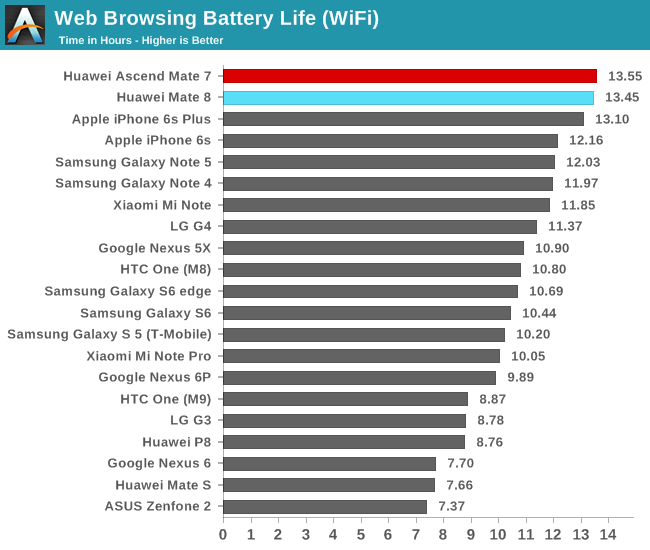
Starting off with our WiFi web-browsing test we see the Mate 8 just get short of 13.5h of battery life. The interesting comparison is here to last year’s Mate 7 as it seems the actually last just as much. This may point out that the screen efficiency measured in our display power testing was maybe correct and the Mate 8 is less efficient. Another aspect is that the Mate 8’s overall platform power consumption hasn’t seen much improvement and thus still represents a large barrier for battery life.
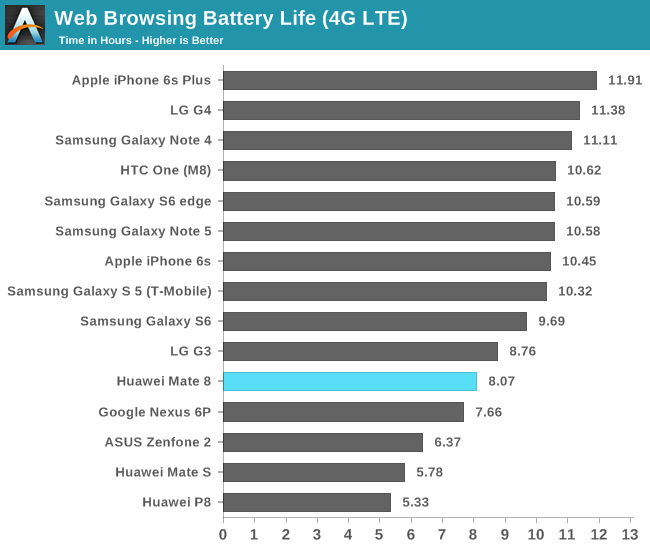
On the 4G LTE test we see that the Mate 8 loses out its advantage over the competition. Again I’m testing under rather mediocre signal conditions so it’s not a valid apples-to-apples comparison to devices reviewed by Joshua or Brandon, however when comparing it against for example such as the Nexus 6P which was tested under the same conditions we see that the Mate 8 faces a much larger battery life degradation going from the WiFi to the LTE test. The reason for this can only be that the Kirin 950’s modem and RF back-end just aren’t as efficient as Qualcomm or even Samsung’s.
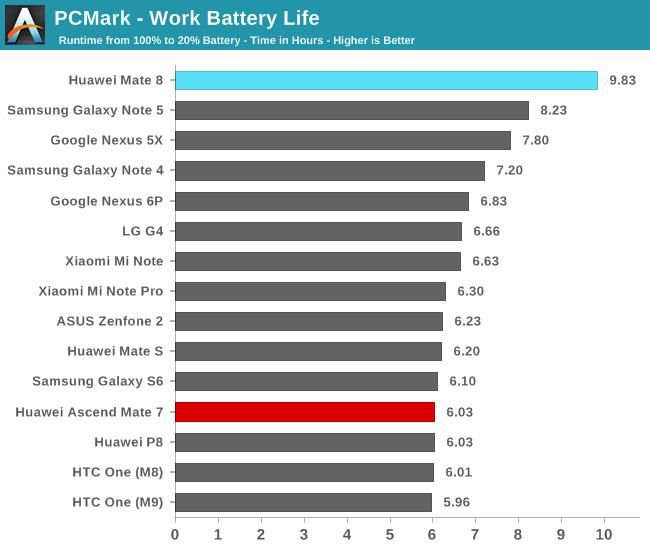
While the web-browsing tests didn’t represent a large improvement for the Mate 8, we see PCMark put the phablet as the current undisputed leader among high-performance devices. Here the difference to the Mate 7 is almost 4 hours, or around a 65% increase in battery life. The increase is most certainly linked to the new SoC’s power efficiency.
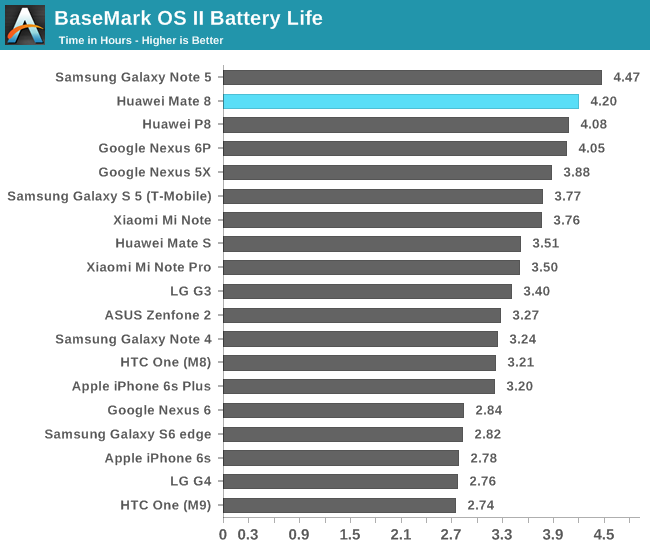
BaseMark OS II’s battery test is more of a maximum load type test that depends on the allowed maximum TDP of the phone. With a 15.2Wh battery and a runtime of 4.2h we see an average consumption of 3.6W, roughly the same amount of power that I saw that the device was able to sustain in our CPU thermal test.

Finally the GFXBench battery test shows that the Mate 8 doesn’t show very good battery life but this is a two-edged sword. As we’ve seen in the GPU section the SoC hardly throttles under heavy GPU load and thus retains its maximum performance for the duration of the test. Considering that the Mate 7 slowed throttled down to 9-10fps and the Mate 8 does not go under 40fps, it still shows that the Mate 8 is twice as efficient as the Mate 7 even though overall battery life is almost twice as short.
At 200 nits the Mate 8 averages an idle power consumption of 989mW and we saw that system load power for the T-Rex test is 3.64W. 3 hours battery runtime averages 5W of power, near the 4.6W we theorized. The small difference may be due to the overhead of actually running the on-screen test and thus also not able to show the DDIC’s savings thanks to PSR due to continuously changing screen content.
Overall I’ve been extremely impressed by the Mate 8’s battery life. In everyday usage this is the longest-lasting device I’ve had the opportunity to use. The Kirin 950’s efficiency is outstanding and is truly able to earn its place among the top for this generation. It seems the Mate 8’s limiting factors are related to the screen and general platform base power consumption, something that Huawei may be able to improve in future devices and thus get even better value out of the Kirin 950.
All being said, if you’re looking for a long-lasting device, you can’t go wrong with the Mate 8.
Charge Time
The Mate 8 advertises fast charging out of the box so that even considering it having a large 4000mAh battery, it should still be fast to fill up when in need. The stock charger is a 9V/2A (18W) unit. I’m not sure if the charging enumeration protocol is based on Quick Charge or Adaptive Fast Charging, but it was able to enable fast-charging on Samsung phones while the Mate 8 didn’t fast-charge on Samsung’s charger, meaning the Huawei charger is likely a Quick Charge unit and the Mate 8’s PMIC and voltage negotiation IC seems to only accept Quick Charge.
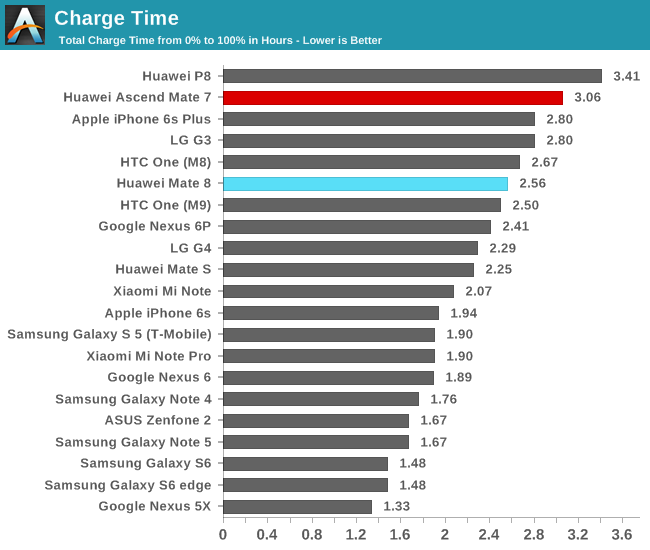
As we see in the charge graph, the Mate 8’s battery cell gets charged at up to 11.5W during the fast-charging phase, being able to reach 80% in 68 minutes around little under 40% charge for each half hour of charging. The last 20% takes up to another 70 minutes as the device switches over to trickle-charging.
While the Mate 8 ends up with total charge time of 2.56 hours, what counts is that the initial 80% of battery capacity can be charged very fast so the Mate 8 is no slouch in this metric.


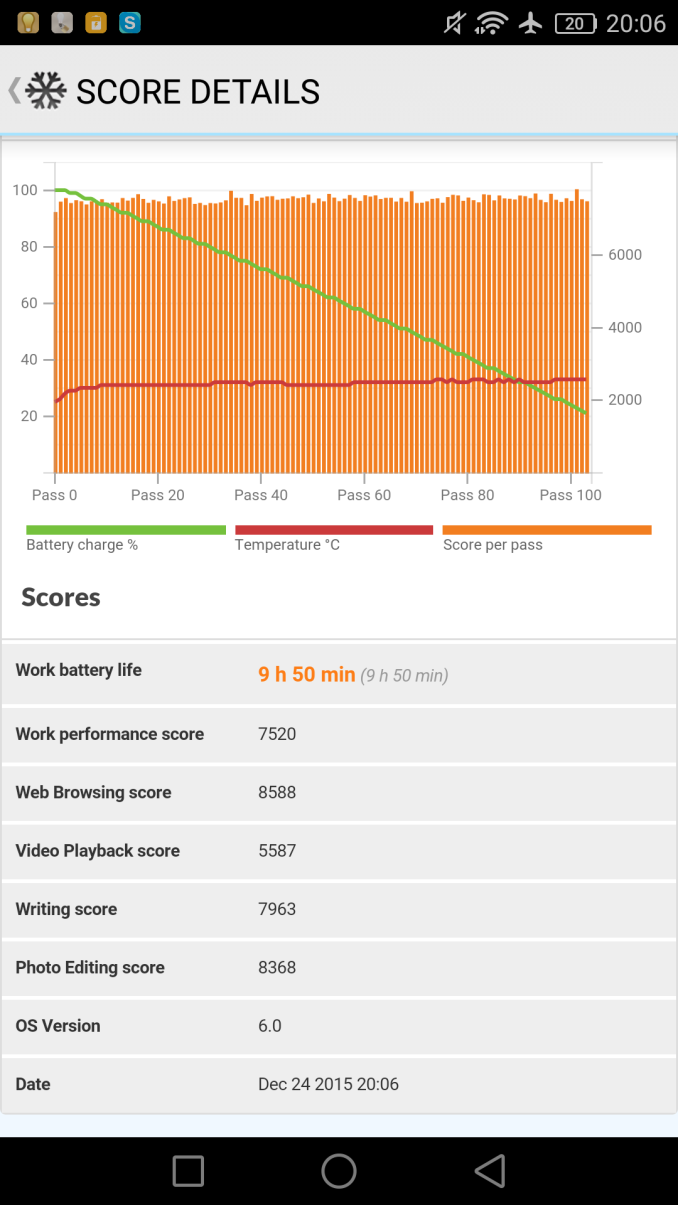
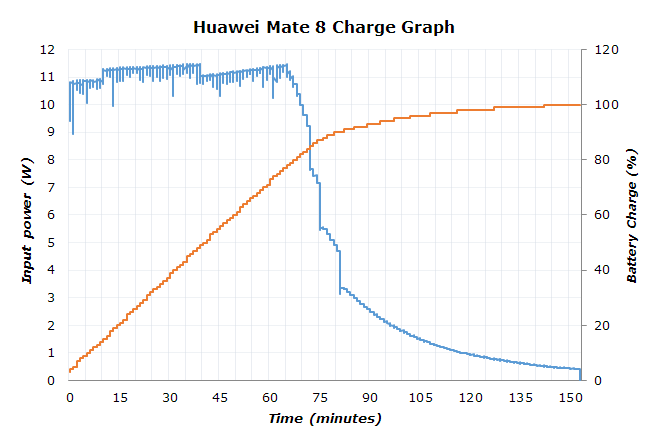








116 Comments
View All Comments
Beany2013 - Tuesday, January 5, 2016 - link
Last update was that it's due - IIRC - before the end of this week unless other schedule conflcts get in the way, from the question being asked on another thread.KPOM - Tuesday, January 5, 2016 - link
Ryan now says on Twitter that the iPad Pro review will be post-CES.lucam - Tuesday, January 5, 2016 - link
Thanks. Still don't understand why it's taking so long...Aenean144 - Wednesday, January 6, 2016 - link
Joshua Ho had finals to study for and to take, then holiday break. Plus, it's going to be harder than your normal review as comparing x86 vs ARM isn't trivial.lucam - Wednesday, January 20, 2016 - link
January is getting over...and no IPad pro review yet...:(ChronoReverse - Tuesday, January 5, 2016 - link
The CPU efficiency results gives me hope for this year's phones. I'm going to have to keep my 6P in good shape and hope that the 2016 Nexus will equal it in every way save the SOC.phexac - Tuesday, January 5, 2016 - link
This is why I finally gave up and went with an iPhone after using exclusively Android phones:"While this is DEFINITELY NOT A PERFECT DEVICE and Huawei can definitely improve in aspects such as SCREEN QUALITY, I’m tending towards calling the Mate 8 a worthwhile purchase – that is, if Huawei manages to fix the SEVERE CAMERA ISSUES."
There are issues like this with every device. Galaxy S6, good but loaded with crapware and has memory leak due to known Android issue. Recent Nexus devices? Fantastic, but color calibration on 6P is iffy and no image stabilizer and long post-processing...and daylight picture quality is inconsistent. Note 5...glass back and crapware. Samsung Edges? Looks GREAT but the edge is a useless gimmick and makes the phone harder to hold.
Finally got 6s Plus and love the fact that everything works without issues. Yeah, I wish the OS were a bit more flexible in some aspects, but it's great to have a phone where all features work well and navigation is ALWAYS smooth. And honestly, after a few weeks, I don't really notice the things I thought were going to annoy me. I do notice the smooth consistent experience every time though.
syxbit - Tuesday, January 5, 2016 - link
Agreed. It seems like the ideal device would be Apple hardware with Google software.QCOM is to blame for the utter disaster of 2015 Android phones. Who would have thought a single company could cause so much damage.
Maybe the ideal future device would be a Pixel phone :).
IanHagen - Wednesday, January 6, 2016 - link
Google software? Oh god, no! Not that Android is bad. No, no, it's great, but for me OS X and iOS are very good reasons to use Apple hardware. From a developer standpoint too, great as Android is, no denying about that, sometimes it makes me want to cry for having to deal with sheer absurdities about it.Ethos Evoss - Wednesday, January 6, 2016 - link
Another naive/pathetic person...